Arlo Needs Glasses
by Barney Saltzberg
Arlo's owner suspects that his beloved pooch has vision problems, and he puts readers who may be facing the same predicament at ease, right along with Arlo, in this entertaining and interactive picture book.
Right from the cover, readers sense that Arlo, a yellow labradoodle, is the center of the boy's universe. The pup's name appears in the equivalent of lights, with the letters outlined in fiesta-bright colors, filled in with contrasting hues and then polka-dotted in a way that suggests small light bulbs on Broadway theater marquees. Arlo loves to play catch with his boy. And the feeling is mutual. The boy begins, "I love my dog Arlo. He likes to play...." Arlo wags excitedly in anticipation, and a gatefold depicts him leaping into the air to catch a red ball with blue, yellow and green dots. The appearance of the ball picks up on the boldly festooned capital letters of the cover. Then one day, suddenly, Arlo can't seem to catch the ball. A sequence of images against a tangerine backdrop shows the red ball bypassing the pup in all manner of ways ("it flew... or zoomed... or whizzed"), and it eventually "bopped him on the nose!" On a lime-green spread, the boy tries and tries to help Arlo, even demonstrating how it's done himself: children pull a tab that guides the ball securely into the boy's mouth. The boy looks so hopeful, tossing the ball to Arlo. Their figures appear as collage cutouts against the green grass and the wide brushstrokes of the blue sky, with slight shadows behind them as they try again. It's the same backdrop as the successful throw-and-catch gatefold in the opening scene. But this time, the ball bounces off the labradoodle's head. ("It was no use. Arlo still couldn't catch.") Nothing works. Then the boy (who, by the way, wears glasses himself) finds the answer in a big red book. (A pull-tab moves both the boy's and dog's eyes from left to right, to show they're reading.) The boy says, "I decided Arlo would need to go have his eyes checked."
As he did with his other fabulous book about solving problems, Beautiful Oops!, Barney Saltzberg exploits the possibilities of the interactive pages. He depicts an eye chart in the doctor's office that someone with 20/20 vision (such as the boy and the eye doctor, both wearing glasses) would see perfectly. With the pull of a tab, the letters blur and we get some idea of what Arlo might be seeing. (Eagle-eyed readers may also detect the words hidden in the eye chart.) The pooch also looks through a kind of neon confetti-colored "phoropter." Here again, as Saltzberg spells out "phoropter," he uses the Broadway-marquee lettering, as if children are picking up a party favor when they look through the accordion-style fancy-dancy binoculars. At the very bottom, in tiny letters, a prognosis awaits ("Arlo needs glasses").
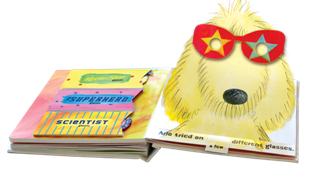
Furthering the party favor theme, Saltzberg provides a trio of glasses in slipcases mounted on the page, for kids to try on Arlo (or themselves)--Movie Star, Superhero, and Mad Scientist spectacles (the latter with festive polka dots in clashing colors that seem to throb against their sturdy, laminated cardboard backdrop). Each fits securely on Arlo's head, which bends slightly forward from the page with a pull-tab. But none of those looks seem quite right for Arlo. He eventually does find the "perfect pair" (on the next page). The bespectacled boy throws the ball (tethered to the page with a yellow ribbon) to his beloved newly bespectacled dog, who catches it securely on the Velcro landing spot in his mouth.
Together, Saltzberg (who also wears glasses, incidentally), Arlo and his boy demonstrate to children with vision problems that there is a simple solution, what to expect at the eye doctor, and how life improves once you can see again. A celebratory finale holds more laughs in store, and plenty more to pore over. Saltzberg once again uses interactive pages to show how problems may be solved with a little effort and a sense of humor. --Jennifer M. Brown



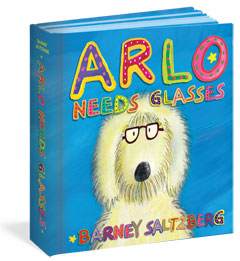
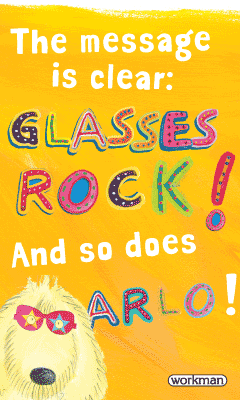
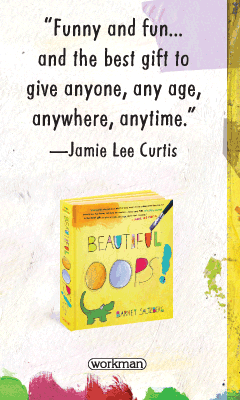

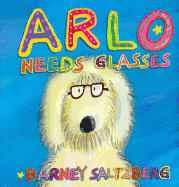

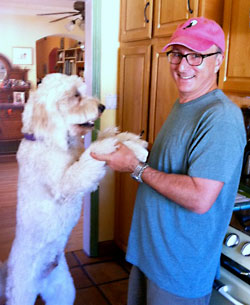 How did you come up with the idea for Arlo Needs Glasses?
How did you come up with the idea for Arlo Needs Glasses?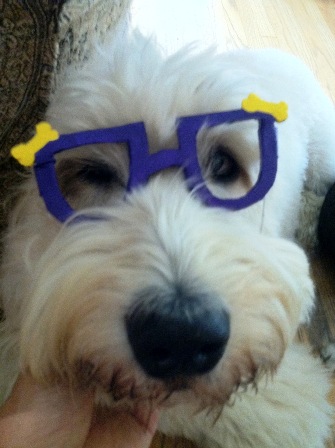 Is that your own dog, Arlo, wearing glasses, in the
Is that your own dog, Arlo, wearing glasses, in the